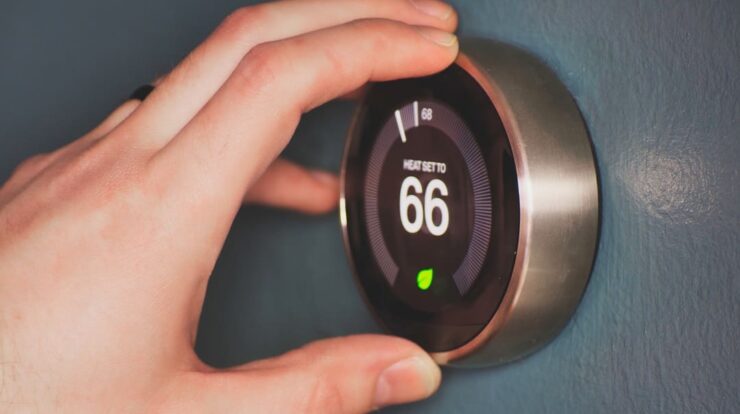
Choosing the right thermostat can help you stay comfortable and save money. But should you go with a smart thermostat or stick with a programmable one? Smart models come packed with features like app control and energy reports, but they also cost more. This post compares both types to help you decide which is a better fit for your home, your routine, and your budget.
What Each Thermostat Type Can Do
Smart thermostats enable you to establish heating and cooling timetables for your residence. You can select specific moments during the day or days of the week when the system should activate or deactivate. Many versions come with an uncomplicated interface featuring screens and buttons to modify temperatures or alter the program. Such control systems suit individuals with consistent routines who prefer minimal adjustments to their settings frequently.
Smart thermostats come with extra features. Many can connect to Wi-Fi and let you change the settings from your phone or another device. Some models track your phone’s location to know when you are away or on your way home. They may also give you reports about how much energy you use and send you reminders to change your air filter.
Some smart thermostats use learning algorithms to adjust the temperature based on your habits. They watch when you change the settings and try to match your routine over time. This means you may not need to set a schedule yourself, as the thermostat can do it for you. Older programmable thermostats do not have this type of feature and only follow the schedule you set by hand.
Connectivity and User Interaction
Intelligent thermostats come equipped with Wi-Fi connectivity, enabling individuals to manage them using their smartphones or tablets remotely. This capability is known as remote access, allowing adjustments to temperatures or schedules without being physically present at home. Additionally, many advanced models incorporate technology referred to as geofencing; this allows the thermostat to detect your proximity to your house via your smartphone’s GPS and automatically initiate heating or cooling prior to your arrival. In contrast, programmable thermostats lack such functionalities. These devices strictly adhere to the programmed schedule entered directly into the unit, requiring you to be onsite for making alterations.
Many smart thermostats work with apps that can be downloaded on a phone. These apps let you manage settings, see your energy use, and get alerts. Some smart thermostats also work with voice assistants like Alexa or Google Assistant. This means you can change the temperature by speaking to your device. Programmable thermostats usually do not work with apps or voice commands. They only have buttons or a touchscreen on the device itself. This makes smart thermostats easier to use for people who want more control from anywhere.
Cost, Rebates, and Savings
Smart thermostats usually cost more than basic programmable models. Smart thermostats can also need a little more work to install, especially if your home wiring is older or if you want to use extra features. Some people choose to have a professional install their smart thermostat, which adds to the total price.
Some utility companies offer rebates or discounts if you buy a smart thermostat. These rebates are meant to help people choose products that can help save energy. The amount of the rebate and the rules for getting it can be different from one area to another, so it is a good idea to check with your local utility company before you buy.
Monthly savings on your energy bill depend on how you use your thermostat and your heating or cooling system. Smart thermostats have features like learning your schedule and remote control through an app. These features can lead to more savings than a regular programmable thermostat, but the real savings vary from one home to the next. Some people notice only a small change, while others see a bigger drop in their bills. Each situation is different, so it is hard to say exactly how much you will save.
Choosing the Right Thermostat for You
Choosing between a smart thermostat and a programmable one hinges on your personal routine, comfort level with technology, and desired connectivity at home. Should you follow a consistent daily pattern and find manual adjustments acceptable, a programmable thermostat could suffice.
However, if your schedule frequently shifts or you desire greater control and automation, a smart thermostat can modify itself based on your behaviors and make adjustments accordingly. These devices come with additional functionalities such as remote accessibility via your smartphone, compatibility with voice-activated helpers, and detailed insights into your energy consumption patterns.
When setting up a smart home or aiming for remote access to your HVAC system, a smart thermostat may be more suitable. However, if ease of use and affordability matter most, a basic programmable version would suffice adequately.
Intelligent Thermostat Compared to Programmable Thermostat
| Smart Thermostat | Programmable Thermostat | |
|---|---|---|
| Pros | More affordable | Remote access |
| Simple setup | Automation | |
| Easier to install | Energy reports | |
| Voice Control | ||
| Geofencing | ||
| Cons | ||
| Fewer features | Learning curve | |
| Manual changes to Temp | Higher cost | |
| No remote access |
In Summary
If you contrast smart thermostats with programmable ones, the primary distinction lies in the additional functionalities offered by smart versions. Programmable thermostats represent a simpler alternative suitable for individuals who maintain consistent routines and aren’t bothered by manual adjustments. While both kinds enable management of heating and cooling systems, smart thermostats provide greater flexibility over controlling your setup and could result in higher energy savings based on usage patterns. Ultimately, selecting between these options hinges upon personal requirements and budget considerations.
Before making your decision, consult your utility provider about potential rebates available for smart thermostats. Additionally, examine your present habits; should they be adaptable or inconsistent, a smart thermostat might simplify things significantly (and reduce costs) over time.
The post
Is a Smart Thermostat Truly Superior to a Programmable Thermostat?
appeared first on
AllTheThings
.






